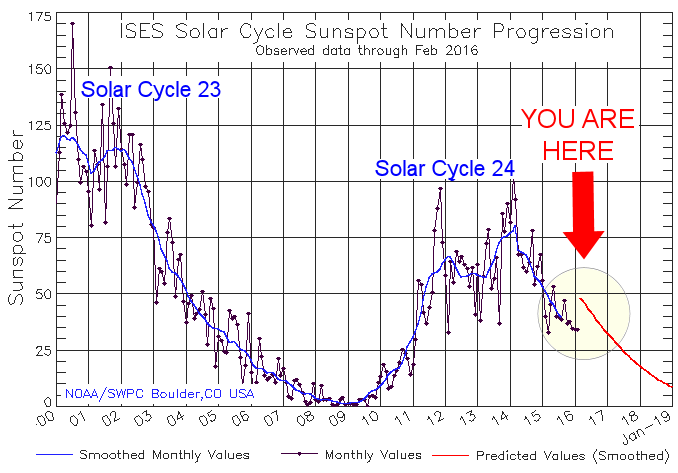Is anyone wondering, why has the sun been so quiet lately?
Answer: The 11-year sunspot cycle is crashing.
(VK6DVR: Doh, don't we all know it!
We'll all be using 'Zimmer frames' by the time Cycle-25 comes around!).
Just look at the numbers in the graph below:

For the past two years, the sunspot number has been dropping as the sun transitions from Solar Max to Solar Min. Fewer sunspots means fewer solar flares and fewer coronal mass ejections (CMEs). As these explosions subside, we deem the sun "quiet."
But how quiet is it, really?
A widely-held misconception is that space weather stalls and becomes uninteresting during periods of low sunspot number. In fact, by turning the solar cycle sideways, we see that Solar Minimum brings many interesting changes.
Lika_sideways_SC.pdf
https://www.vsp.ucar.edu/Heliophysics/p ... ays_SC.pdf
For instance, the upper atmosphere of Earth collapses, allowing space junk to accumulate around our planet. The heliosphere shrinks, bringing interstellar space closer to Earth. And galactic cosmic rays penetrate the inner solar system with relative ease. Indeed, a cosmic ray surge is already underway.
http://news.spaceweather.com/cosmic-ray ... intensify/
(Goodbye sunspots, hello deep-space radiation.)
Stay tuned to SpaceWeather.com http://spaceweather.com/ for updates as the sunspot number continues to drop.
VK6DVR: Hey, fellow VHF HAMmers, all is not lost, do not despair too much.
A downward sunspot-cycle should inspire VHF Radio Amateurs (particularly those 6M 'Magic-band' tragics), to experiment more and explore the limits of propagation more intensely than just relying on the ionosphere jiggling those electrons hotter during cycle peaks.
Some topics to inspire you to not abandon our hobby, (just yet):
* Equinoctial TEP will still be available during cycle lows, albeit fewer, shorter openings, probably digi-modes only. For those dudes averse to computers, get a mate to set it up for you, then put yourself on WSPR for starters, then graduate to other QSO-type digi-modes once you've had some experience. You'll be surprised how easy it is at the end of the day.
* If you're not already using one, build a masthead combo LNA (Low-Noise Amplifier) with a bypass relay of ~70-80dB contacts isolation, and use low-loss coax runs, so those WSPR and JT65 decodes and EME signals improve.
* Experiment more with antenna technologies - if you haven't got the antenna, you haven't got the weak signals. But, it doesn't have to be the biggest, just fit-for-purpose.
* Meteor-Scatter: Many of you on the Eastern AU seaboard have perfect separation distances to play with MS comms. How about some software and use the internet to determine Meteor Shower quadrants recorded live from a triangulation of stations, so that those fewer, but 'larger' bolides trajectories can be passed onto those planetary scientists. Just a few each decade.
* Follow the 'Hepburn Charts' and pickup some interesting Tropospheric Propagation paths.
* Yes, it's fine having a rotatable 5-el, 6-M LFA yagi, pointing in your preferred direction, but unless you have a stacked horizontally-polarized omnidirectional running, you may miss out on hearing sigs/beacons in the yagi nulls.
I proved that nicely during last 2015 Xmas-Eve's Es opening, where, while up in NW-WA up in Broome, from a very meagre omni-antenna made by crossing 2x full-wave loops and then cable-tied to a pool-fence at 2M high, I managed a triple-kangaroo-hop WSPR report all the way to Dunedin at the bottom of NZ's Sth island.
With WSPR running almost 24x7, and without having to go out into any Broome heat and 'Armstrong' any yagis, sigs from the lower SW of WA (normally off a yagi null) gave me reports with signal strengths far greater than expected from such an antenna. Satisfaction guaranteed, for building this antenna, testing it with my SARK-110 Antenna Analyzer, leaving it exactly where it was setup for vSWR testing and then persevering with it for the duration of the Es season, simply to prove it can be fun, no matter how poor you might have felt that it would have worked.
Chin up boyz and girlz!